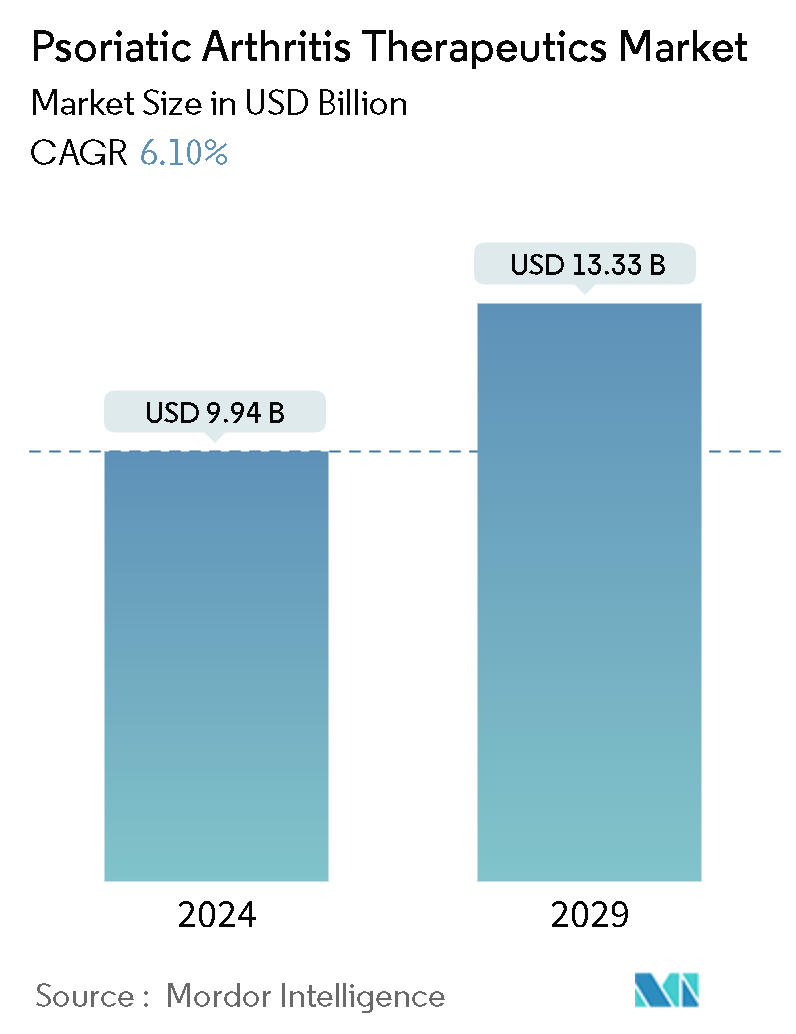Market Size of Psoriatic Arthritis Therapeutics Industry

| Study Period | 2019 - 2029 |
| Market Size (2024) | USD 9.94 Billion |
| Market Size (2029) | USD 13.33 Billion |
| CAGR (2024 - 2029) | 6.10 % |
| Fastest Growing Market | Asia Pacific |
| Largest Market | North America |
Major Players
*Disclaimer: Major Players sorted in no particular order |
Psoriatic Arthritis Therapeutics Market Analysis
The Psoriatic Arthritis Therapeutics Market size is estimated at USD 9.94 billion in 2024, and is expected to reach USD 13.33 billion by 2029, growing at a CAGR of 6.10% during the forecast period (2024-2029).
Factors such as the increasing prevalence of psoriatic arthritis associated with obesity and strong pipeline products are anticipated to boost the market's growth.
The increasing cases of psoriasis globally and the increasing demand for psoriasis drugs for treatment are major drivers of market growth. For instance, according to the study published in Rheumatology International in August 2023, the prevalence of psoriatic arthritis (PsA) at age 60 is expected to increase from 1% in 2019 to over 3% by 2050, with a more significant rise in women, reaching approximately 3.5%. Such a rise in psoriatic arthritis would increase the adoption of its treatments, driving market growth.
According to the study published in UpToDate Journal in April 2024, psoriatic arthritis (PsA) affects both genders equally, with an annual incidence of approximately 6 cases per 100,000 individuals and a prevalence of about 1 to 2 cases per 1,000 in the general population. Therefore, the high annual incidence is anticipated to increase the demand for psoriatic arthritis treatments, boosting market growth.
In addition, the development of new therapeutic methods, such as novel drugs with oral administration, is expected to drive market growth. For example, in November 2022, Janssen Pharmaceutical Companies of Johnson & Johnson launched a new posthoc analysis of the Phase 3 DISCOVER program evaluating TREMFYA (guselkumab) in adult patients with active psoriatic arthritis.
The results showed that early skin and enthesitis responses predicted longer-term clinical responses, including disease remission, at week 52. Additionally, regulatory authorities approving new drugs, such as AbbVie's SKYRIZI (risankizumab-rzaa), an interleukin-23 (IL-23) inhibitor for treating adults with active psoriatic arthritis, are contributing to market growth.
Factors such as the rising incidence of psoriatic arthritis and companies increasingly developing psoriatic arthritis drugs are expected to contribute to market growth. However, the high cost of treatment is expected to hamper market growth.
Psoriatic Arthritis Therapeutics Industry Segmentation
As per the scope of the report, psoriatic arthritis is a form of arthritis that affects some people with psoriasis, a condition that develops red patches on the skin with silvery scales. Psoriatic arthritis therapeutics include drugs that help relieve pain, reduce inflammation, slow the progression of psoriatic arthritis, or directly target parts of the immune system that trigger inflammation.
The psoriatic arthritis treatment market is segmented by drug class, route of administration, and geography. By drug class, the market is segmented into nonsteroidal anti-inflammatory drugs (NSAIDs), disease-modifying antirheumatic drugs (DMARDs), immunosuppressants, biologic agents, and others. By route of administration, the market is segmented into oral, parenteral, and others. By geography, the market is segmented into North America, Europe, Asia-Pacific, the Middle East and Africa, and South America. The report also covers the estimated market sizes and trends for 17 countries across major regions globally. The report offers the value (USD) for all the above segments.
| By Drug Class | |
| Nonsteroidal Anti-Inflammatory Drugs (NSAIDs) | |
| Disease-Modifying Antirheumatic Drugs (DMARDs) | |
| Immunosuppressants | |
| Biologic Agents | |
| Other Drug Classes |
| By Route of Administration | |
| Oral | |
| Parenteral | |
| Other Routes of Administration |
| Geography | ||||||||
| ||||||||
| ||||||||
| ||||||||
| ||||||||
|
Psoriatic Arthritis Therapeutics Market Size Summary
The psoriatic arthritis treatment market is poised for significant growth, driven by the increasing prevalence of the condition and the development of innovative therapeutic solutions. The market is expected to expand steadily over the forecast period, supported by a robust pipeline of new drugs and therapies. The rising incidence of psoriatic arthritis, particularly among populations with obesity, is a key factor propelling market expansion. The introduction of novel treatment methods, such as oral administration drugs and interleukin inhibitors, is further enhancing the market landscape. Regulatory approvals for new therapies, including those targeting specific biological pathways, are expected to bolster the adoption of these treatments, contributing to the overall market growth.
North America is anticipated to dominate the psoriatic arthritis treatment market, attributed to the region's high prevalence of the condition and the availability of advanced therapeutic options. The established healthcare infrastructure in countries like the United States and Canada facilitates the rapid adoption of new treatments, driving market demand. Strategic initiatives by key market players, including partnerships and licensing agreements, are enhancing the accessibility of psoriatic arthritis therapies, further propelling market growth. The market is characterized by a semi-consolidated structure, with major players investing heavily in research and development to maintain their competitive edge. These dynamics, coupled with the increasing demand for effective treatments, are expected to sustain the market's upward trajectory in the coming years.
Psoriatic Arthritis Therapeutics Market Size - Table of Contents
-
1. MARKET DYNAMICS
-
1.1 Market Overview
-
1.2 Market Drivers
-
1.2.1 Increasing Prevalence of Psoriatic Arthritis Associated with Increasing Obesity
-
1.2.2 Strong Product Pipeline
-
-
1.3 Market Restraints
-
1.3.1 High Cost of Treatment
-
-
1.4 Porter's Five Forces Analysis
-
1.4.1 Threat of New Entrants
-
1.4.2 Bargaining Power of Buyers/Consumers
-
1.4.3 Bargaining Power of Suppliers
-
1.4.4 Threat of Substitute Products
-
1.4.5 Intensity of Competitive Rivalry
-
-
-
2. MARKET SEGMENTATION (Market Size by Value - USD)
-
2.1 By Drug Class
-
2.1.1 Nonsteroidal Anti-Inflammatory Drugs (NSAIDs)
-
2.1.2 Disease-Modifying Antirheumatic Drugs (DMARDs)
-
2.1.3 Immunosuppressants
-
2.1.4 Biologic Agents
-
2.1.5 Other Drug Classes
-
-
2.2 By Route of Administration
-
2.2.1 Oral
-
2.2.2 Parenteral
-
2.2.3 Other Routes of Administration
-
-
2.3 Geography
-
2.3.1 North America
-
2.3.1.1 United States
-
2.3.1.2 Canada
-
2.3.1.3 Mexico
-
-
2.3.2 Europe
-
2.3.2.1 Germany
-
2.3.2.2 United Kingdom
-
2.3.2.3 France
-
2.3.2.4 Italy
-
2.3.2.5 Spain
-
2.3.2.6 Rest of Europe
-
-
2.3.3 Asia-Pacific
-
2.3.3.1 China
-
2.3.3.2 Japan
-
2.3.3.3 India
-
2.3.3.4 Australia
-
2.3.3.5 South Korea
-
2.3.3.6 Rest of Asia-Pacific
-
-
2.3.4 Middle East and Africa
-
2.3.4.1 GCC
-
2.3.4.2 South Africa
-
2.3.4.3 Rest of Middle East and Africa
-
-
2.3.5 South America
-
2.3.5.1 Brazil
-
2.3.5.2 Argentina
-
2.3.5.3 Rest of South America
-
-
-
Psoriatic Arthritis Therapeutics Market Size FAQs
How big is the Psoriatic Arthritis Therapeutics Market?
The Psoriatic Arthritis Therapeutics Market size is expected to reach USD 9.94 billion in 2024 and grow at a CAGR of 6.10% to reach USD 13.33 billion by 2029.
What is the current Psoriatic Arthritis Therapeutics Market size?
In 2024, the Psoriatic Arthritis Therapeutics Market size is expected to reach USD 9.94 billion.

